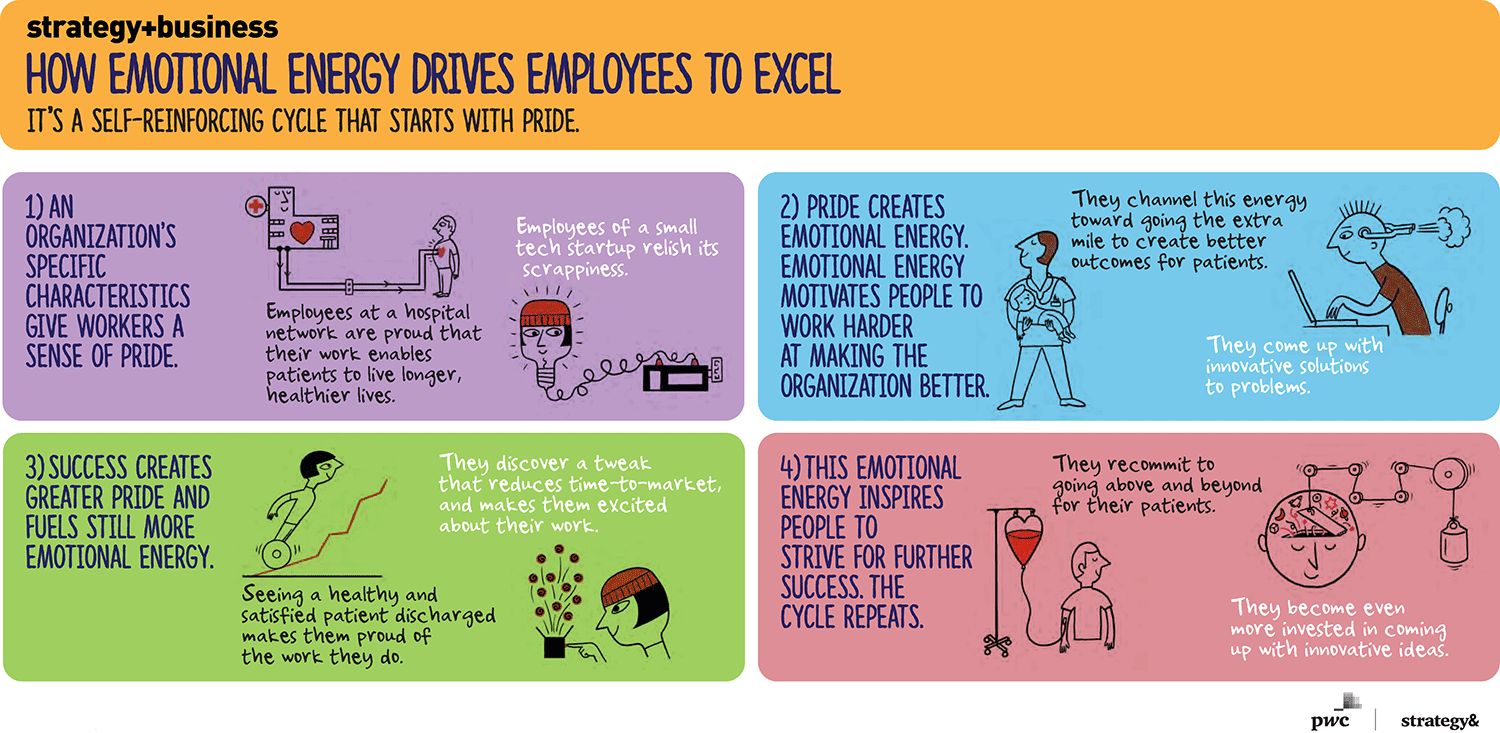How to harness employees’ emotional energy
Fuel success by linking a company’s strategic goals to the reasons people are proud to work there. See also “How Emotional Energy Drives Employees to Excel.”
When we at the Katzenbach Center ask a client’s employees what it is that makes them proud to work there, we often marvel at how consistent the answers are throughout an organization, regardless of level, function, or team. These cultural anchors aren’t always immediately obvious to outsiders, but if you take a bit of time to speak with individuals within an organization, you will begin to uncover them.
Employees at a mission-based hospital network may be driven by the knowledge that their work enables patients to live longer, healthier lives. People working for a blue-chip company may take special pride in being associated with a premium, globally recognized brand. Individuals working at a startup may wear its related scrappiness as a badge of honor. Workers at a factory may relish their part in its paternalistic role as provider — of jobs, economic growth, and tax revenue.
This pride fuels “emotional energy,” something critical to both our understanding of organizational culture and employee engagement.
In a prior blog post, I discussed the fact that high scores on employee engagement do not always mean that your culture is supporting your strategy; and conversely, that low engagement scores do not necessarily mean that your culture is “flawed” or “broken.” Essentially, culture evolution is not synonymous with improving employee engagement. I did, however, mention one area of overlap — that is, when you identify critical behaviors that drive performance directly and harness sources of emotional energy, thereby also driving engagement. Let’s look more at what this means.
Emotional energy drives employees to go above and beyond, regardless of external incentives such as compensation and benefits. Specific strengths that are sources of pride within a company feed this emotional energy, which in turn drives people to work harder toward bettering the organization. The sense of pride that comes from this achievement further fuels emotional energy, motivating people to strive for even further success. And so the cycle repeats.
In Why Pride Matters More than Money: The Power of the World’s Greatest Motivational Force (Crown Business, 2003), Jon Katzenbach explains that pride is an emotional high that follows success. Anticipation of future successes serves as an intrinsic source of motivation, which is often more powerful than formal incentives and rewards.
The ability to harness these sources of pride becomes especially important during periods of change and disruption. According to the Katzenbach Center’s Culture and Change Survey, during large-scale change efforts, companies that use employee pride/emotional commitment or the existing culture as a source of strength are almost twice as likely to achieve sustainable change as compared to companies that do not use these resources.
The ability to harness these sources of pride become especially important during periods of change and disruption.
This is because absent attention, transformation efforts can threaten sources of pride, and thus your organization’s emotional energy. Think about a company that has always stood for treating employees as family. A large, impersonal organizational restructuring program could easily lead to the perception that employees are now just head count to be moved around.
When these cultural touchstones are under attack, employees become demoralized and can resist change. Counterproductive behaviors arise, including paying lip service to efficiency targets and hiding information in order to protect individual teams. It is then little wonder when a couple years down the road, costs have crept back up, shadow organizations have formed, and the company finds itself having to undergo yet another restructuring.
It may be tempting to try to change these sources of pride. During a cost-reduction effort, for example, it would be much easier if employees suddenly took pride in being lean. Culture, however is something that evolves over time and is difficult to change.
To fully harness an organization’s emotional energy, it is imperative to link the goals of the organization to the things that make people proud to work there. Our approach to culture evolution at the Katzenbach Center relies on the idea that you need to be purposeful and selective in how you tackle culture; we call this approach getting to the “critical few” behaviors. And, ultimately, if you have correctly chosen those critical few behaviors upon which to focus, you will see people behaving in ways that move the company forward while also feeling more invested in its success.
For example, at the hospital network mentioned above, the goals of an efficiency program can be linked to an improved experience for patients — asking employees to streamline processes in order to create a more seamless experience is a lot more motivating than asking them to do the same in order to reduce waste and improve the hospital’s bottom line. The right culture interventions thus directly link to performance goals and improve employee engagement via inspiration.
However, the link between sources of pride and business goals must be genuine. This is not merely a communications exercise in which one crafts a story about how cutting costs benefits customers, and then moves on to cut frontline staff and impose rules on time spent with each customer. Embedding a culture-led approach to transformation requires thoughtful integration of cultural insights into the work itself — in the identification, prioritization, and sequencing of transformation activities.
There are individuals within a company who, as authentic informal leaders, already intuitively understand all of this. These pride builders excel at harnessing intrinsic sources of motivation among their teams in order to improve performance. They get to know their teams personally, and help members to see the purpose and impact of their work, tying this impact to the things that make these individuals tick.
Companies would do well to similarly uncover their unique sources of emotional energy, and draw upon this rich resource in order to drive both stellar business results and an engaged, motivated workforce.






